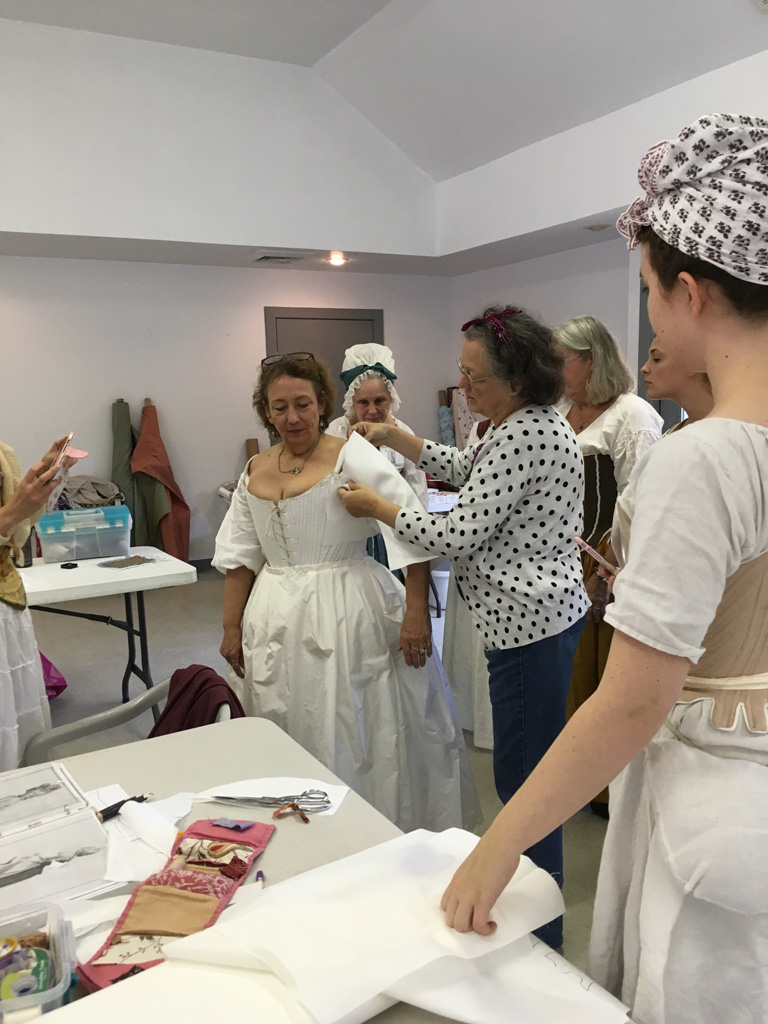Early last November, I made the seven-hour trek down to Williamsburg to attend my first Burnley and Trowbridge workshop, “A Fitting Jacket”. I’d been interested in them for years, but never worked up the courage to attend. Either the timing didn’t work for me, or I was too intimidated to sign up. Of course, I shouldn’t have worried. It was challenging in some ways but in the end, it was a wonderful experience.

Janea teaches us to drape sleeves using Angela as a model.
We met Angela, the proprietor of B&T, and our instructor Janea, the head millinery/mantua maker at Colonial Williamsburg on Friday afternoon. The workshop started with an overview of late 1700s jackets, illustrated with a slideshow featuring examples of extant jackets, portraits, and fashion plates. We went over the basic pattern shapes used to achieve these styles, and then paired up to start draping jackets on our partners. This is where I ran into my first set of challenges.
Janea’s approach to sewing and patterning is very different than the method I’ve evolved over the years sewing only for myself, without anyone to help with the fitting process. Even after all these years, I tend to make half a dozen or more mock ups, tweaking the fit of a pattern or refining the style, before I even begin to think about cutting my fabric. Janea taught us to drape directly on the body, as they would have done in an 18
th century mantua maker’s shop, and any fitting issues were to be fixed in the final jacket fittings. As you can imagine, this was very much out of my comfort zone, but still a good opportunity to learn new skills. I admit, I have little to no experience draping on a different body type, so my partner’s pattern was not a nicely fitted as I would have liked, but thankfully Janea and Angela were there to give advice and step in when needed to make sure everyone walked out with a good jacket.
Because I was so busy working on my new stays and new habit jacket in the weeks leading up to the workshop, I didn’t have more than a vague idea of what kind of jacket I wanted. For a normal project this wouldn’t be a problem – I’d refine my design in the mock up stage - but I severely underestimated how important this stage is to my creative process. I’m so used to starting with an idea and then playing with the muslin on the form or my own body until it crystalizes in my mind. Without that, I had a hard time visualizing what I wanted and then communicating that to my partner. Eventually, we did come up with a nice design but I feel I wasted more time than I should have. Next workshop I will definitely come prepared with a solid plan of what I want to make!
Finally, I always knew I was a relatively slow sewer, but the mad rush of sewing over the weekend really drove this home. The way the workshops are set up, you have to complete one part of your jacket before you can move on the next step. There is a lot of time to work, but consistently, I was among the slowest. I even had to switch from the neat weird whipstitch technique Janea demonstrated to my standard spaced backstitch method because I just wasn’t fast enough with the other stitch. In the end my jacket is mostly basted together, even just pinned in places, but Janea and Angela made sure I left with all the key pieces fitted (including sleeves!) and all the knowledge I needed to finish my jacket at home. One of the things that worried me most before the workshop was the fact that I might not be able to keep up or finish what I needed, so I appreciated their “no man left behind” policy. I highly recommend the experience and can’t wait to take another one in the future!
Posted:
10/31/2017 3:42:38 PM by
Aubry | with
comments